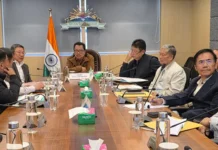[ CI Mannou ]
This article aims at ex-ploring the legend of Chongkham and narrating the myth about our ancestors, based on broad historical phases.
With this view, I once paid a social visit to the house of a senior citizen, who was sitting alone on the verandah of his bamboo hut. After meeting him, I was soon engrossed in listening to his story, as if they had occurred only a few years ago.
It was an interesting story. Spending time with him, I myself started feeling old. However, I kept my patience as it is a virtue to gain success, and I continued to sit down beside the old man to learn about the Khamtis.
According to him, the Tai-Khamtis are descendants of the great Tai race. The word ‘Khamtee’ was coined by the local people of Assam, whereas the Khamtees called themselves ‘Tai’, as it was a generic name denoting a branch of the great Tai race.
The Khamtis possessed great warfare skills. They entered Assam through the Patkai range. They could establish supremacy in the occupied region because of the successively weak Ahom kings. But after rapid political changes, they could not continue having the status of legitimacy.
Later, under the British appeasement policy, some Khamtis were shifted to Assam, and some settled down in the Tengapani basin and the Noa-Dihing region, in the present Namsai district of Arunachal. Chongkham was established in the 18th century, on the bank of two rivers. Chongkham, therefore, is one of the oldest villages in Namsai district and Arunachal, as well.
With the passing of time, Chongkham earned the reputation of being a political centre as late Chow Khamoon Gohain (Namchum) was nominated in 1952 as the first MP of the NEFA, and continued till 1960. Again, after late Daying Ering, MP, late CC Gohain (Namchum) from Chongkham was nominated as the MP of the NEFA in 1971, and continued upto 1977.
Chongkham carries a beautiful meaning, which stands for ‘Golden Temple’, as the roof of the temple was coated with gold plate. It looks more beautiful with the rising sun adding an extra golden hue to it. Today Chongkham is home to about 2000 families, which makes it one of the largest Khamti villages in Namsai district.
Chongkham is a land of dignity of social customs as its people are still preserving their unique cultural heritage and show hospitality to the elders.
Like all Khamtis, the people of Chongkham are Buddhists of the Thera-vada sect. The daily life of the people of Chongkham revolves around the Buddhist monastery.
The Chongkham Buddhist monastery was established in the 18th century, and is one of the longest and oldest monasteries in the region. The Khamtis believe in the Buddhist ideal of ahimsa as a cardinal virtue, and that all living beings have the spark of divine spiritual energy. Therefore, to hurt another living being is to hurt oneself.
Besides, they also believe in the Buddhist ideal of right thinking and right living, and understand that desire and greed block the path to eternal bliss.
Therefore, in Chongkham our people perform sacred rituals each day to make sure that their families remain constantly blessed with good fortune.
The Khamtis preserve their own script, which is regularly taught at the monastery by the learned monks.
The Khamtis wear traditional woven cloths. So, in Chongkham, every family has looms where women weave traditional garments, making designs and colours according to people’s ages, which symbolize identity and social status. They also maintain their traditional food habits. Rice is their staple food, which indicates that their main income comes from agriculture.
Now, coming to the modern century, Chongkham is growing by leaps and bounds into a thriving commercial centre. So, we are now thinking to bring a big change by talking in the legislature for administrative might of Chongkham and its circle. (The contributor is a retired principal, based in Chongkham.)



